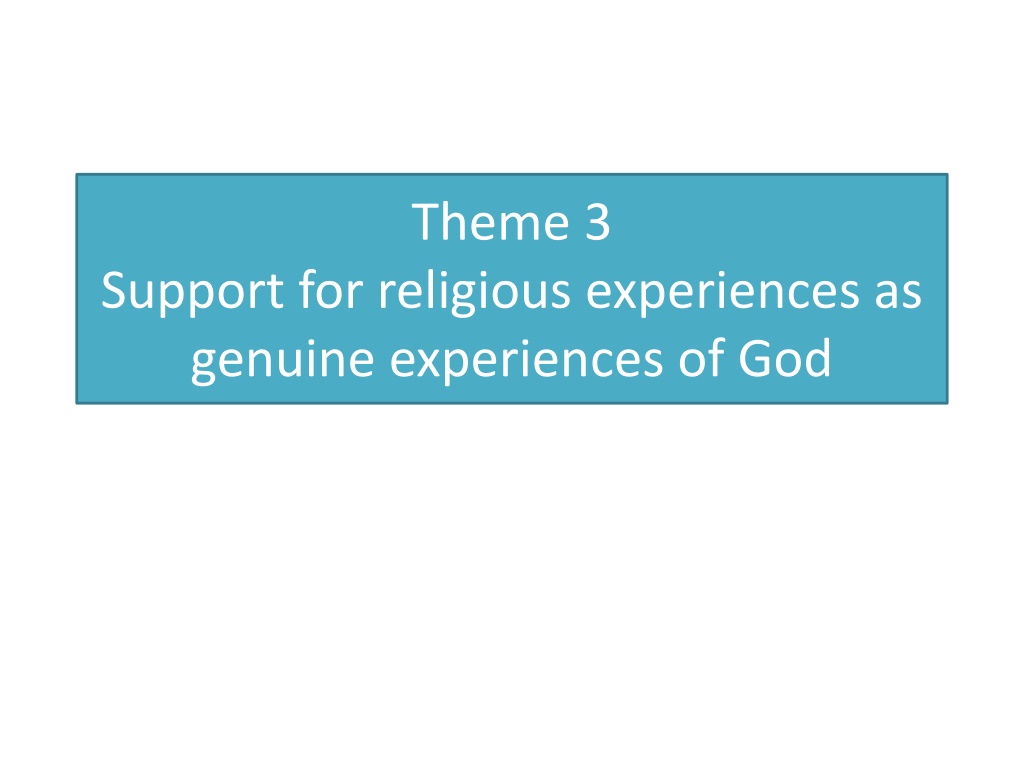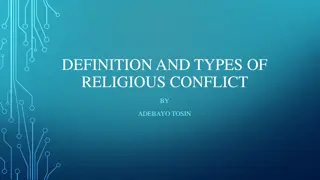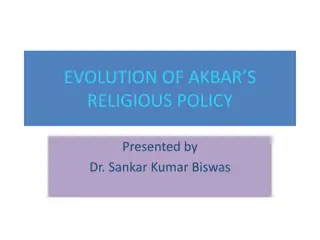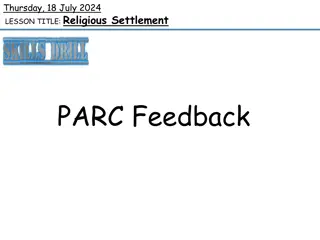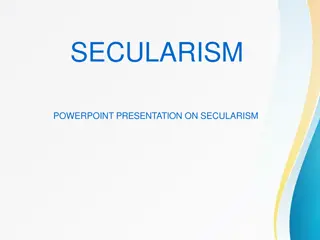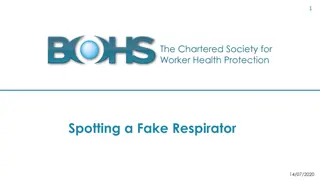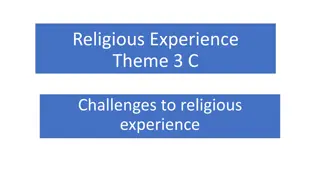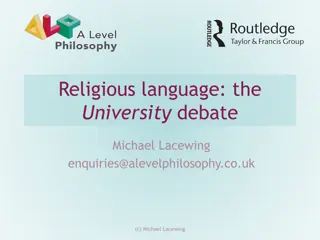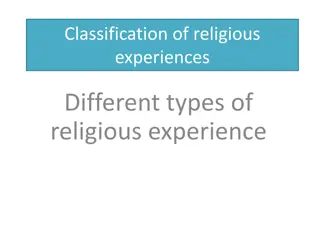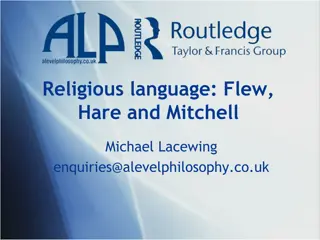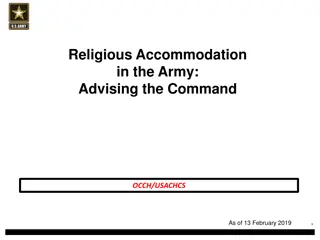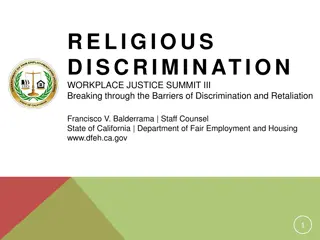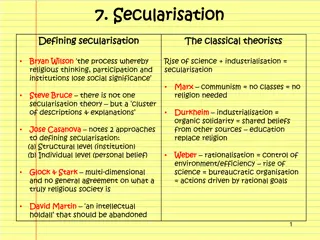Understanding Genuine Religious Experiences: Support and Evaluation
Explore the authenticity of religious experiences as encounters with God. Delve into challenges supporting these experiences, individual validity, impact on individuals, and testing methods, including the Catholic Church's evaluation process for visions. Discover insights from William James and St. Teresa on the significance and testing of religious experiences.
Download Presentation

Please find below an Image/Link to download the presentation.
The content on the website is provided AS IS for your information and personal use only. It may not be sold, licensed, or shared on other websites without obtaining consent from the author. Download presentation by click this link. If you encounter any issues during the download, it is possible that the publisher has removed the file from their server.
E N D
Presentation Transcript
Theme 3 Support for religious experiences as genuine experiences of God
Which challenge is missing? What is the missing challenge? Think of three pictures that could be used to symbolise it
Challenges (support for religious experiences): individual experiences valid even if non-verifiable; claims could be genuine integrity of individual; one-off experiences can still be valid even if never repeated. 1.Life changing 2.St Teresa of Avila s test 3.Catholic Churches test 4.Swinburne Principle of Testimony and Credulity 5.Corporate experiences
They are genuine because of the impact on the individual William James
They are genuine as they can be tested St. Teresa s St. Teresa claimed that RE s should: Conform to the teachings of the church; i.e. relate to scripture Result in increased charity and acts of humility Meet with the approval of a spiritual director i.e. a priest who accepts the validity of the RE
How do we assess whether a vision is genuine? The Catholic Church has a procedure for assessing the truth value of visions based on an evaluation of the facts of the alleged event
Some positive criteria that need to be met.. 1. Evaluation of the individuals personal qualities: mental balance, a moral life, obedience to Church authority, willingness to practice faith 2. Evaluation of the content of the vision: they must agree with the faith and morals of the Church 3. It results in healthy devotion: greater prayer, works or charity etc.
4. After this evaluation is approved by the Bishop there must be a lengthy period of devotion that results in a deepening of the recipients faith 5. Finally comes Papal acknowledgment The Lourdes visions were declared authentic in 1862 (4 years after Bernadette s visions)
Example-the Fatima visions October 1917 3 shepherd children witnessed a vision of the Virgin Mary She also communicated 3 secrets to them
Were the Fatima visions genuine? Verified The visions occurred during a time when the Freemasons had gained influence in Portugal and tried to limit the power of the Catholic Church Many Catholics felt persecuted leading to a religious split in the country Some view the visions as an attempt by the Church to win back political control therefore . . .
They are genuine experiences of God because it is reasonable to accept people s alleged experiences In his book (Is There a God?) Swinburne claims that it is reasonable to suppose that God would seek to engage and interact with his creation. If God exists, we should expect religious experiences to take place. Swinburne defends the idea that those experiencing God should believe what their senses tell them. He calls this the Principle of Credulity. He also argues that we should trust those who give accounts of religious experiences, if there is no reason to doubt them. He calls this the Principle of Testimony.
Essentially, Swinburne is trying to leave the burden of proof with those who doubt experiences. If we experience something, we tend to assume that this experience is genuine. Why should it not be the same with religious experiences? religious If such experiences are genuine, it is reasonable to conclude that God or some higher power probably exists.
Challenges to Swinburne J. L. Mackie Perhaps people are telling the truth, however they could be deliberating deceiving, they could be mistaken and have misinterpreted whatever they have felt and incorrectly assumed it came from God Michael Martin Swinburne s principles could be used to lead to the conclusion there is no God. Atheists experience the world as Godless. Using T and C what would they conclude?
Corporate Experiences Toronto blessing https://www.youtube.com/watch?v=_P5B5Brz_lc 1. Using the internet and the info sheet, write an account of the events of the Toronto Blessing, including reference to the influence of the experience on individuals. 2. Read the account of the first Day of Pentecost in Acts 2:1 21 (New Testament). In what ways are the experiences of the apostles similar to those who have experienced the Toronto Blessing?
Toronto Blessing 10th January 1994 at Toronto Airport Vineyard Church (and replicated in a variety of settings since this time) Recorded as an outpouring of the Holy Spirit Individual testimonies of the participants do contain differences Descriptions given by witnesses are remarkably similar: People falling in the Holy Spirit people fall to the ground or are stuck to the fall by Holy Ghost Glue Shaking the body shakes under the power of God Weeping said to be a result of repentance for sins or for the burden of the souls of those not saved Laughter expression of the joy experienced when the Holy Spirit enters your life (this is a controversial element, seen by some as mass hysteria ) The blessing occurred during a sermon by Pastor Randy Clark and witness, Pastor John Arnott, described 80% of people were on the floor it was like an explosion. We saw people literally being knocked off their feet by the spirit of God others shook and jerked some danced, some laughed. Some lay on the floor as if dead for hours. People cried and shouted. The first recorded experience of this type was in 1979 by South African minister, Rodney Howard-Brown. Howard-Brown considers himself to be the Holy Ghost bartender , dispensing the new wine of joy leading to people being drunk in the spirit
Starter How can we show religious experiences are genuine? List five methods for establishing validity of REs 1. 2. 3. 4. 5. Which do you think is most effective Why? Which do you think is least effective Why?
Religious experiences have a significant impact on religious belief and practice Significant Not significant
James four characteristics adequately define mystical experiences.
Ottos definition of numinous experiences is adequate
